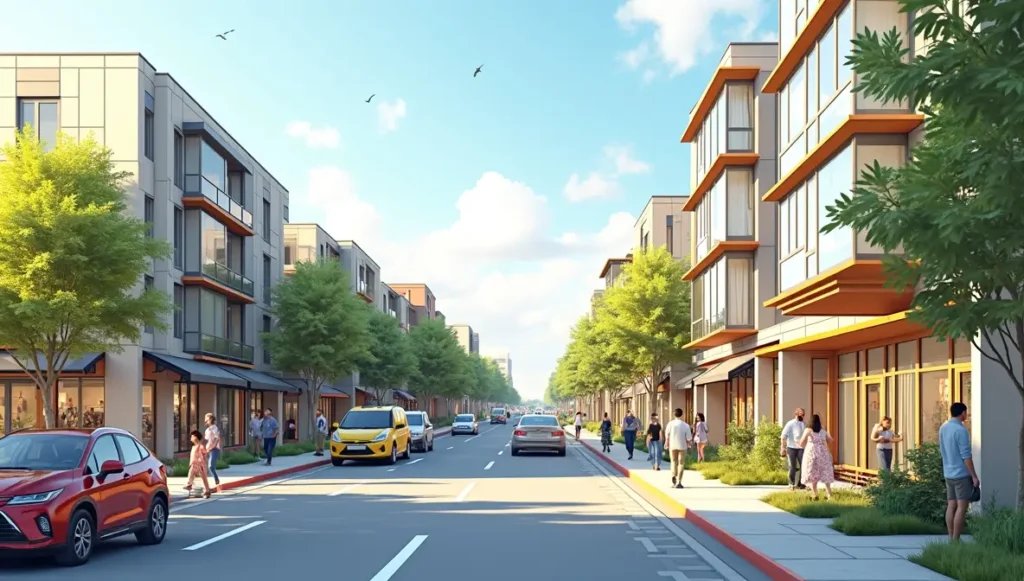In today’s rapidly evolving urban landscape, our concept of home is undergoing a transformative shift. Modern co-living spaces are more than just shared apartments—they’re dynamic communities that blend affordability with authentic connection. Imagine a living environment that not only lightens your financial load but also nurtures meaningful relationships and sparks innovative lifestyles.

Have you ever paused to reflect on how your everyday surroundings could actively contribute to your personal growth and sense of community? Instead of simply noting the changes in our living arrangements, consider this: what if your home could serve as a platform for creativity, collaboration, and a healthier, more sustainable way of life?
Key advantages of co-living include:
- Affordability: Shared resources and costs make urban living accessible without compromising quality.
- Community Building: Living among like-minded individuals fosters an environment where friendships flourish and support networks thrive.
- Sustainable Practices: Emphasizing resource sharing and eco-friendly initiatives, co-living spaces pave the way for a greener future.
Recent insights from the Harvard Joint Center for Housing Studies highlight that co-living is more than a fleeting trend—it’s a strategic response to the challenges of modern urban life.
Understanding the Concept of Co-living Spaces
In today’s dynamic urban environment, traditional housing models are being reimagined. Co-living spaces have emerged as a transformative solution, blending the benefits of community living with the practicality of shared resources. This innovative concept goes beyond merely splitting rent—it fosters an ecosystem where affordability, connection, and flexibility converge to create truly livable communities.

What Are Co-living Spaces?
At its core, co-living refers to residential environments where individuals share common areas while maintaining private living quarters. This model has evolved in response to:
- Rising Housing Costs: As urban centers become more expensive, co-living offers a financially savvy alternative.
- Desire for Community: In a fast-paced world, many are seeking genuine connections and supportive social networks.
- Flexibility and Convenience: With fully managed amenities and communal services, residents can focus on their careers and personal growth rather than household maintenance.
Evolution and Global Trends
The co-living definition has expanded significantly over the past decade. What began as experimental housing arrangements in select urban areas has now blossomed into a global trend. Here’s a brief timeline of its evolution:
- Early Experiments: Small groups sharing living spaces to reduce costs and build community.
- Modern Co-living Communities: Professional environments designed for young urbanites, integrating technology and flexible living arrangements.
- Future-Forward Models: Innovative setups that incorporate smart home features, sustainability practices, and even coworking spaces.
Recent insights from the Harvard Joint Center for Housing Studies underscore that these trends are not only sustainable but also a strategic response to the evolving needs of urban dwellers.
Key Benefits at a Glance
Embracing co-living can redefine urban living by offering:
- Economic Advantages: Shared costs lead to more affordable urban living without sacrificing quality or location.
- Enhanced Social Connectivity: Living among like-minded individuals paves the way for lasting friendships and collaborative ventures.
- Streamlined Living: With on-site amenities and professional management, residents enjoy a hassle-free lifestyle.
Benefits for Residents: Community Building & Cost Efficiency
Co-living spaces offer a unique blend of financial advantages and community enrichment that redefines urban living. By sharing common areas and resources, residents enjoy a lifestyle that’s not only cost-effective but also socially engaging.

Building a Strong Community
Living in a co-living environment naturally fosters connections. When you share your living space with like-minded individuals, you’re more likely to experience:
- Meaningful Interactions: Daily opportunities to engage with neighbors can lead to lasting friendships.
- Support Networks: A built-in community means instant access to advice, emotional support, and collaborative projects.
- Shared Experiences: From communal dinners to collaborative events, these shared moments enhance personal growth and social cohesion.
Recent research by Statista highlights the growing trend of community-centric housing models that emphasize quality of life alongside financial practicality.
Achieving Cost Efficiency
One of the primary draws of co-living is its affordability. By pooling resources, residents can enjoy:
- Reduced Living Costs: Splitting rent, utilities, and maintenance expenses makes urban living far more accessible.
- Access to Premium Amenities: Many co-living setups include high-end shared spaces and services—like fitness centers, co-working areas, and fully furnished common rooms—without the premium price tag.
- Flexibility: Shorter lease terms and all-inclusive packages reduce the burden of long-term financial commitments and unexpected costs.
A Balanced Lifestyle
In a world where both personal well-being and financial stability are paramount, co-living spaces strike a perfect balance. They create an environment where residents can:
- Focus on What Matters: With daily expenses managed collectively, you can redirect your energy toward hobbies, career development, or family.
- Experience Urban Living Fully: Embrace the vibrant culture of the city without the stress of exorbitant costs.
The synergy between community building and cost efficiency transforms co-living from a simple housing option into a lifestyle choice—one that enriches both your social life and financial health.
Impact on Urban Dynamics and Local Economies
Co-living spaces are more than just innovative housing alternatives—they’re catalysts for urban revitalization and drivers of local economic growth. As cities evolve, these shared living models are transforming neighborhoods by attracting diverse residents and stimulating commercial activity.

Revitalizing Urban Neighborhoods
The emergence of co-living spaces plays a significant role in breathing new life into urban areas. This transformation can be observed in several key areas:
- Enhanced Neighborhood Vibrancy: Co-living communities bring a mix of cultures and lifestyles that invigorate the social fabric of a neighborhood.
- Attraction of Creative Industries: With an emphasis on flexible living, local arts, and tech startups, these spaces foster environments where creativity thrives.
- Improved Urban Infrastructure: Increased demand for amenities such as cafes, coworking spaces, and boutique retail outlets helps modernize local infrastructure.
Recent studies from the Brookings Institute provide strong evidence that innovative housing solutions like co-living can trigger positive changes throughout urban communities.
Stimulating Local Business and Economic Resilience
The economic impact of co-living extends benefits to both residents and local businesses:
- Job Creation: The development and maintenance of co-living spaces generate employment in sectors from property management to hospitality.
- Boosting Local Spending: Residents often spend more within their communities, benefiting small businesses, restaurants, and retail shops.
- Attracting Investment: As urban areas become hubs for innovative living, investors are drawn to these rejuvenated neighborhoods, spurring further development.
A Synergistic Urban Evolution
By merging affordable living with community engagement, co-living spaces drive an urban evolution that:
- Creates vibrant, interconnected communities.
- Fosters a robust local economy through increased consumer activity and strategic investments.
- Serves as a model for sustainable and resilient urban development.
Innovative Trends and Future Opportunities in Co-living
The future of co-living is being shaped by technology, sustainability, and evolving lifestyle demands. As this housing model gains momentum, it’s transforming how we think about community, work, and the environment.
Embracing Smart Technologies
One of the most exciting trends is the integration of smart technology into co-living spaces. This innovation enhances convenience and adds layers of security and efficiency:
- Intelligent Home Systems: Automated lighting, climate control, and security features that adapt to residents’ routines ensure comfort and energy efficiency.
- Digital Platforms for Community Engagement: Mobile apps and online forums facilitate resource management, community events, and seamless communication.
- Data-Driven Living: Advanced sensors and analytics help optimize shared amenities, making operations more efficient and cost-effective.
Insights from the Forbes Technology Council illustrate how digital platforms are revolutionizing shared living environments.
Prioritizing Sustainability
Sustainability is a key driver behind the evolution of co-living:
- Energy-Efficient Designs: Many modern co-living spaces incorporate green materials and renewable energy solutions like solar panels.
- Resource Sharing: Pooling resources reduces the overall carbon footprint while promoting sustainable consumption.
- Waste Reduction Initiatives: Recycling, composting, and minimizing single-use products are becoming standard practices.
Reports from GreenBiz provide ample evidence that eco-friendly co-living appeals to an increasingly environmentally conscious population.
Future-Forward Living Environments
Looking ahead, co-living spaces promise even more opportunities for enriched urban lifestyles:
- Hybrid Living and Working Models: Incorporating co-working spaces and flexible workstations to support remote work.
- Customizable Living Experiences: Modular living setups adaptable to individual needs, from families to single residents.
- Integrated Wellness Facilities: On-site fitness centers, meditation rooms, and wellness programs enhancing residents’ quality of life.
These trends underscore a cultural shift toward living environments that prioritize connectivity, sustainability, and adaptability.
Addressing Common Challenges in Co-living Environments
While co-living spaces offer numerous benefits, they also present unique challenges. Understanding and addressing these issues can help ensure a harmonious and thriving community.
Balancing Community Living with Personal Privacy
Finding the right balance between social interaction and personal space is crucial:
- Thoughtful Design: Incorporate soundproofing, private nooks, and designated quiet zones.
- Clear Community Guidelines: Establish policies that promote respectful use of shared spaces.
- Technological Enhancements: Smart home systems can help manage access to common areas, enhancing security and privacy.
Navigating Operational and Management Challenges
Managing co-living spaces effectively requires:
- Robust Digital Platforms: Centralized systems for maintenance requests and community updates streamline operations.
- Regular Communication: Scheduled meetings and feedback sessions help address concerns proactively.
- Professional Management: Experienced property managers ensure smooth day-to-day operations and regulatory compliance.
For further industry benchmarks and best practices, insights from the Urban Land Institute are invaluable.
Tackling Regulatory and Operational Hurdles
Co-living spaces operate within complex regulatory frameworks. Addressing these challenges involves:
- Staying Informed on Local Regulations: Keeping up-to-date with housing laws and safety standards.
- Comprehensive Insurance Measures: Clear insurance policies and liability agreements protect all parties.
- Standardized Rental Agreements: Transparent contracts outlining expectations reduce potential conflicts.
Strategies for a Harmonious Co-living Experience
To maintain a positive community atmosphere:
- Conflict Resolution Mechanisms: Structured processes for resolving disputes quickly.
- Continuous Feedback Loops: Regular surveys help identify areas for improvement.
- Ongoing Adaptation: Periodically reviewing community policies ensures they meet evolving needs.

In wrapping up our exploration of co-living spaces, it’s clear that this innovative model is more than just a housing alternative—it’s a transformative way to experience urban living. By merging affordability with community engagement, co-living offers a fresh perspective on sharing resources, building meaningful connections, and adapting to modern urban challenges.
Have you ever considered how shared living could reshape your lifestyle? With co-living, the benefits extend far beyond reduced costs. You gain a dynamic community that nurtures creativity, supports personal growth, and enhances overall well-being. Whether it’s the convenience of smart technologies, a commitment to sustainability, or the promise of a more connected way of life, co-living is paving the way for a future that meets the needs of today’s urban dwellers.
As you reflect on the insights shared in this post, consider exploring further. For more detailed analysis on urban housing trends and innovative living solutions, check out the in-depth research available at the Urban Land Institute. Additionally, resources from the Brookings Institute offer valuable perspectives on how shared living models are influencing urban development globally.
Ultimately, co-living is about reimagining what home can be. It challenges traditional norms and invites us to envision a lifestyle where community and efficiency go hand in hand. So, as you navigate the evolving landscape of urban living, ask yourself: could co-living be the key to unlocking a richer, more sustainable future?





